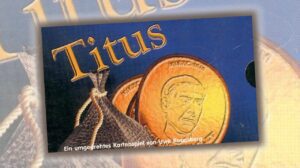Overview
Imperial Settlers, designed by Ignacy Trzewiczek, is a card game of civilization and engine building. Each player selects one of four factions (Romans, Egyptians, Barbarians, or Japanese) and uses the corresponding Faction deck in conjunction with a deck of Common cards to produce resources, acquire more cards, build locations, and to score points. The game is played over a total of five rounds and the person who has accumulated the most points at the end of the game wins.

In this multi-article series, I am going to discuss Imperial Settlers and all of its expansions. I’ll tell you how they work, how they change the game, and what I think about them. In this article, I’m going to turn my focus on just the base game.
- In Imperial Settlers Review – The Empire Packs – Part 02 I talk about the first two small box expansions.
- In Imperial Settlers Review – The Atlanteans- Part 03 I discuss the Atlanteans faction.
- In Imperial Settlers Review – The Aztecs – Part 04 I talk about the Aztecs.
- In Imperial Settlers Review – The Amazons – Part 05 I discuss the Amazon faction.
- I’ve also reviewed related games Imperial Settlers: Roll & Write and Imperial Settlers: Empires of the North
Components
Imperial Settlers is primarily made up of five decks of cards. There are Faction decks for each of the four different factions (that only the player controlling that faction can use) and there is a deck of Common cards which will be available to all players. Additionally, there is a scoreboard, four faction tokens used to track each player’s progress along the scoring track, four faction boards (one per faction), a Round marker, and a start player token. There is also a very detailed and well designed rule book. And, then there are the variety of resource bits – wooden bits representing food (red), wood (brown), stone (grey), and workers (pink) and cardboard tokens representing gold coins, swords used for razing things, and shields used for defending things.
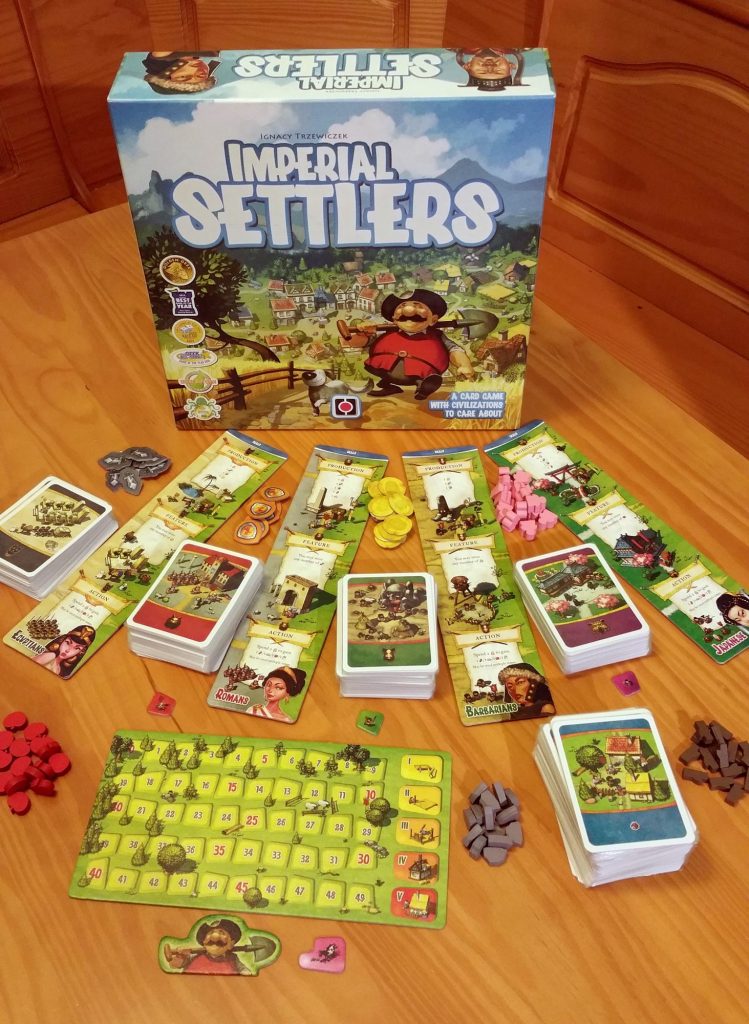
The quality of the various components are top notch. The cards are crisp and durable and the tokens and scoreboard are all made of thick cardboard. The rulebook, as I mentioned, is incredibly well written and lavishly illustrated with tons of examples. It is also worth noting here that they’ve even included a QR code that will take you directly to a how-to-play video so that you can jump right in without having to pore over the rule book. The wooden pieces are what you’d expect from a euro game. They look great when they’re piled onto your cards and they have a nice tactile quality about them.

Now, if you find yourself playing this game several times a week like me, you’ll probably want to consider investing in some card sleeves. While there are a lot of card sleeving options out there to choose from, I wound up settling on KMC’s Perfect Size sleeves. Not only do they hug the cards tightly, they’re also very well regarded on Amazon and, at just under $20 for 600, they’re a great bargain as well! I also recommend investing in some kind of organizer because, once you begin adding the various expansions, the set up and break down for this game can get tiresome. The right organizer will have you up and running in no time.
I use The Broken Token’s Imperial Settlers organizer personally, but there are a few others out there to choose from. Just make certain that whichever you choose can accommodate sleeved cards if you decide to take that route.

If reading about how the game is actually played bores you, then feel free to scroll down to the THOUGHTS section. However, if you’re wondering how to actually play the game…
Setup
The setup for Imperial Settlers is pretty easy (especially with an organizer – I can’t stress this enough!). First, all of the various resources tokens and bits are separated into piles and set somewhere close by along with the scoreboard. Then, each player selects a faction and takes their Faction deck, shuffles it, and places it facedown nearby along with the appropriate faction board. They will also place their faction token onto the 0 space of the scoring track. The Round marker is placed onto the first space on the scoreboard and the Common deck is shuffled and placed face down within easy reach of all of the players. Next, each player draws two cards from their Faction deck and receives two cards from the Common deck. A starting player is chosen, receives the starting player token, and you’re ready to begin.
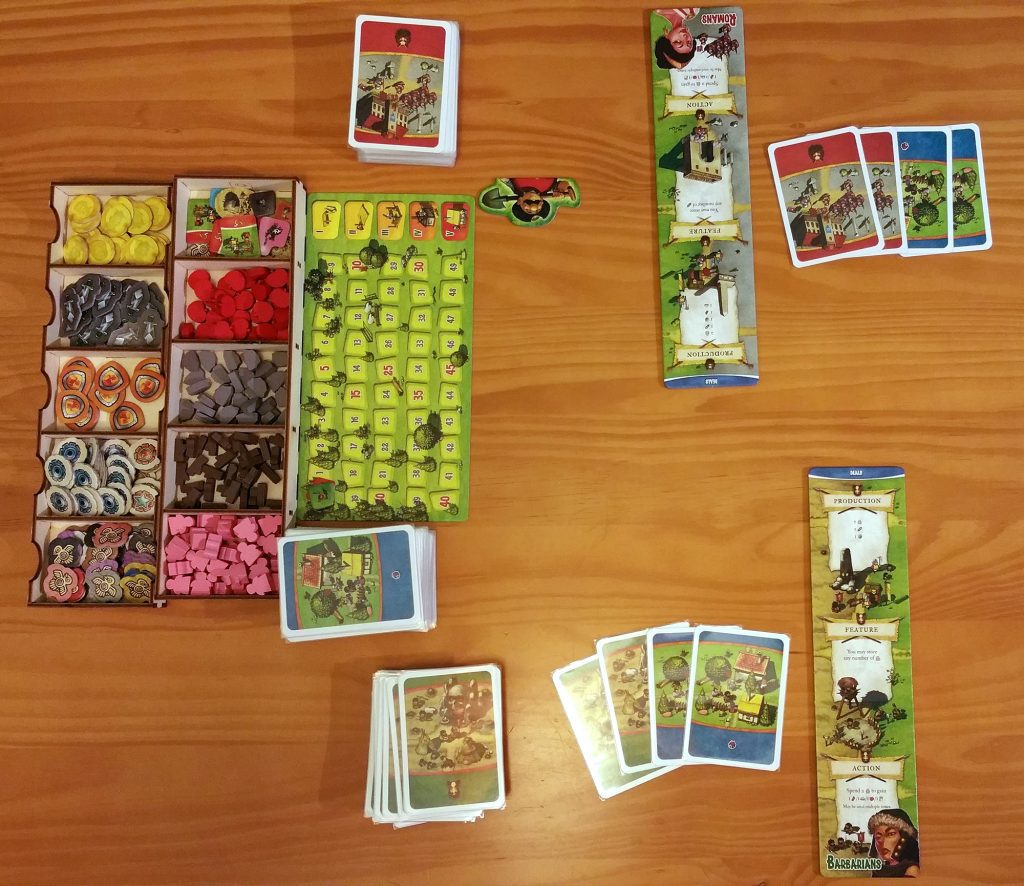
The Faction Boards

Each player begins the game with a faction board in front of them which is divided into four sections. At the top of the board is the Production area. Beneath this is the Feature area. Under this is the Actions area. Finally, at the bottom of the card is an area which describes one of the actions that is available to all players at any time during their turn. I’ll get to the various actions in a little bit and will refer to this as ‘the common action’ when I do so.
When the players are constructing locations (a.k.a. playing cards from their hands), there is a building convention that should be followed. Any common locations that the player constructs should be placed on the right side of their faction board. Any faction locations should be placed on the left. Furthermore, any ‘production’ locations (the cards are conveniently labeled) should be placed in the ‘production’ row while the other types should also be constructed in their appropriate rows.
The Cards
Every card in the game has several properties which they share in common. Firstly, in the upper left hand corner of each card is the card’s build cost. This dictates which items the player building the card should return to the supply. Typically, these costs are some mixture of resources (food, stone, and wood) or goods (everything else). Some faction cards, though, will require you to give up one of your already constructed common locations in order to construct them. The card used to do this is referred to as a ‘foundation’. The foundation would simply be discarded in this instance.
In the upper right hand corner of all of the Common cards (as well as the Japanese faction cards) there is an area labelled “Raze to Gain”. This dictates which rewards a player razing this card will receive for doing so. I will cover the ‘raze’ action later. In the middle of the card is an illustration which depicts whatever the card is supposedly doing. At the bottom of the card is the card’s title along with text which specifies which type of card the card is, the name of the card, and what the card actually does. While the food, wood, stone, gold, and worker symbols are all fairly self-explanatory, the blue star represents movement on the scoring track.

Anatomy of a Turn
The game lasts for a total of five rounds. The rounds are broken down into several phases. Those phases are:
Lookout Phase: in this phase, the players will add a card from the Faction deck to their hands and then take turns drafting from a number of cards that will be drawn from the Common deck. The number of cards that are available to be drafted from depends upon the player count.
Production Phase: during this phase, players will receive all goods produced by their production cards, any deals they may have made (more on making deals shortly), and their default production that is depicted on their faction boards.
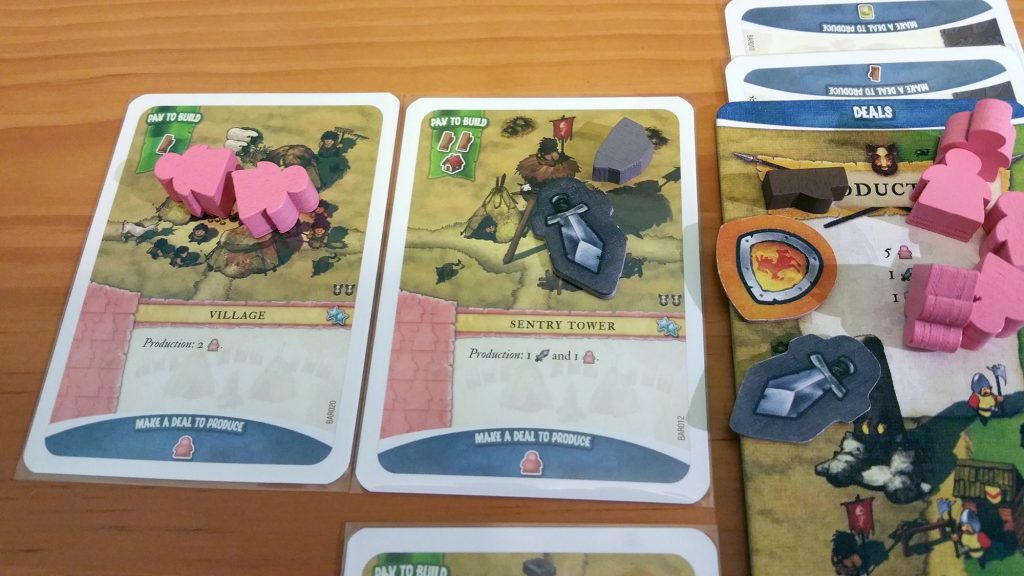
Action Phase: beginning with the start player, each player will take turns performing a single action at which point it becomes the next person’s turn. The players keep taking turns, performing actions, until a player passes. When that player passes they can no longer participate in the round and they become untargetable by other people’s actions. The players keep taking turns until everyone has passed. The possible actions are:
Construct a location: the player selects a card from their hand, pays the cost associated with constructing the card, and then places the card into play in its proper location. If the constructed location is a production location, the player receives the good(s) that that card provides immediately. Players will also receive any building bonuses associated with constructing the location.
Make a Deal: the player will return 1 food to the general supply. Then the card is flipped upside down and placed beneath the “Deals” section at the top of their faction board. That player immediately receives the goods depicted and will continue to receive these goods during future production phases
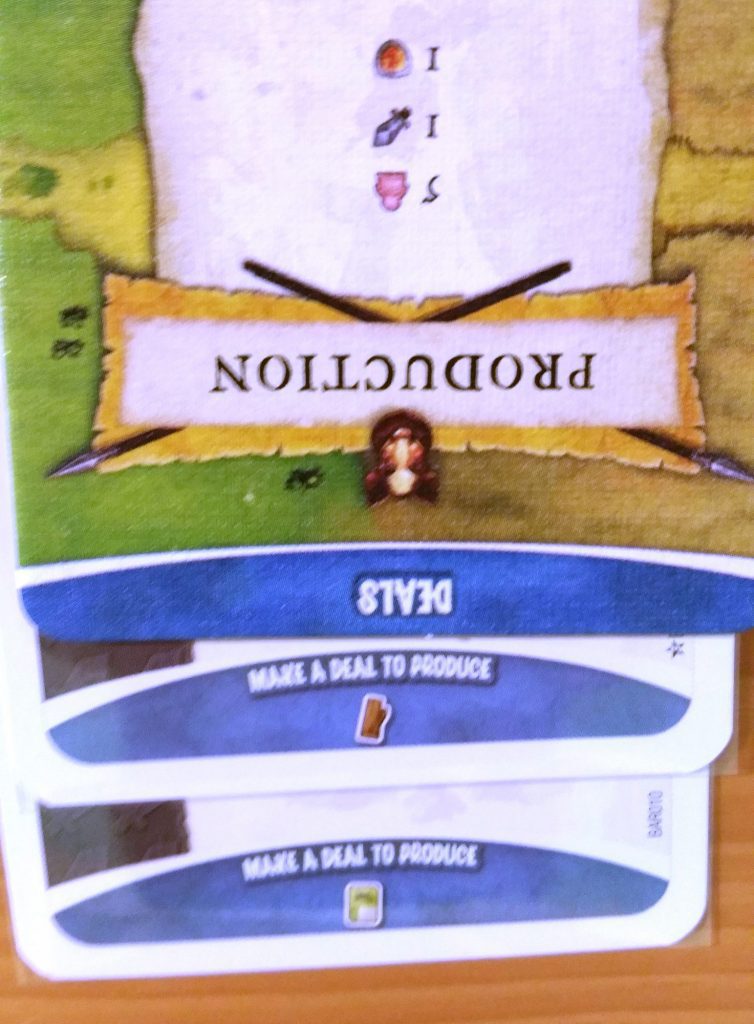
Place a Defense token: this is a free action and does not count towards a player’s ‘one action per turn’ limit. The player may place as many defense tokens onto as many of their Common locations as they wish, one token per location, so long as they have the defense tokens to do so.
Raze: the player may select any card that has a “Raze to Gain” section on the card (either from play or their hand) and then returns the appropriate number of raze tokens to the supply. They then gain whatever the rewards are for razing the card. It costs 1 raze token to raze from your hand and 2 to raze an opponent’s location from play. If that location has a defense token on it, it will cost a total of 3 raze tokens to raze it. When a location is razed from play, the owner of that location will flip the card to its opposite side and receive 1 wood in compensation. This flipped over card may be used as a foundation when constructing other locations that call for a foundation.

Common Action: the player may trade two workers to the general supply to receive either 1 food, 1 stone, 1 wood, or draw a card from either their Faction or the Common deck. This action may be performed multiple times per round.
Use an Action card’s ability: the player will pay the card’s ability cost – placing the paid costs onto the card – and then perform the action. If any action can be performed multiple times, the player can choose to perform all of those iterations simultaneously or break them up over other turns. This includes the ‘common action’. For instance, a player could pay 4 workers to draw a card as well as take a stone from the supply all in one single action.

Pass: if the player cannot or chooses not to do anything else, then they may declare that they are passing. Since passing is considered an action, the player cannot perform some other action and then declare that they are passing on the same turn.
Cleanup Phase: in this phase, the players will return any unused goods back to the general supply along with any goods that might have been used to activate various card actions during the previous phase. There is one exception to this. Each faction has one good that they may store and carry over to the next round. The good varies from faction to faction and is shown on the ‘feature’ section of their player board. The Egyptians, for instance, can carry over gold.
Endgame & Scoring
The game ends after the final player has passed at the end of the fifth round. At this point, each player’s faction locations will be worth 2 victory points apiece and their common locations will be worth 1 each. These victory points are added to their current total and the player with the highest victory point total wins.

Thoughts
Let’s get this right out there – I LOVE Imperial Settlers. It has quickly become my favorite game. In fact, it’s rare for a day to go by that this game doesn’t hit my table. It’s just THAT good. If you follow me on Twitter (@FeldFreak) you will have undoubtedly noticed me constantly posting photos of the game or stuff about the game. I just can’t get enough of it. Just writing this article has got me jonesing to play it again.
So, just what is it that makes this game so good?
That’s a hard thing to put my finger on. It begins with the aesthetic. The artwork on the gamebox and the cards is awesome. Tomasz Jedruszek’s drawings are cheeky, fun, and full of tiny little details that it’s easy to miss if you’re not looking for them – like this cat slinking around The Mill.
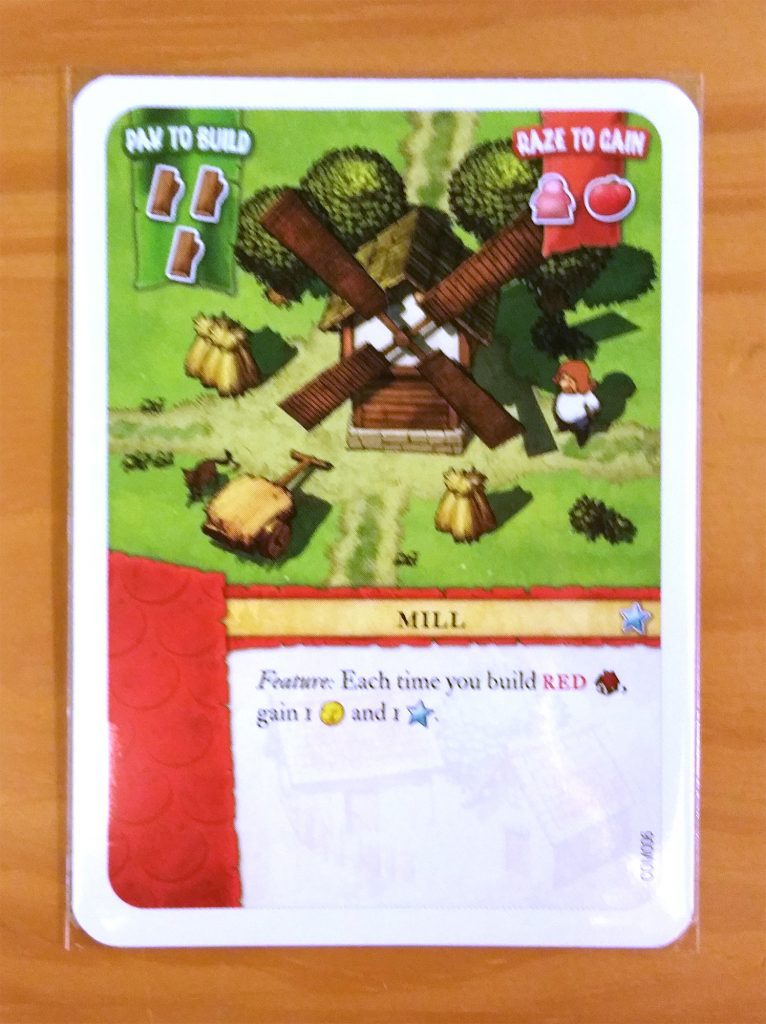
It was that artwork that initially caught my eye. The pleasant looking chap on the front of the box, walking along the road with his dog creates a feeling of warmth and welcomeness. It’s only after playing the game that you realize that his easy smile could just as easily be a self-satisfied smirk…that the shovel on his shoulder could just as easily have been used to cause someone else grief as it could have been to dig a hole. All of the artwork is this way. Even when the characters depicted are involved in doing something nefarious, they are unquestionably adorable while they are doing it.
What drew me in further was actually seeing someone else play it from afar. I had no idea what they were doing, but seeing that massive display of cards with wooden pieces all over the place just sang to me. For me, all of those tiny wooden pieces are like a siren’s song. Ever since playing The Settlers of Catan and Agricola, I’ve come to associate lots of wooden bits and pieces with the call signs of a good game. Very rarely has this instinct led me astray. Imperial Settlers is one of those times that my instincts served me well. After seeing it being played, I knew that it was a game that I absolutely HAD to play.
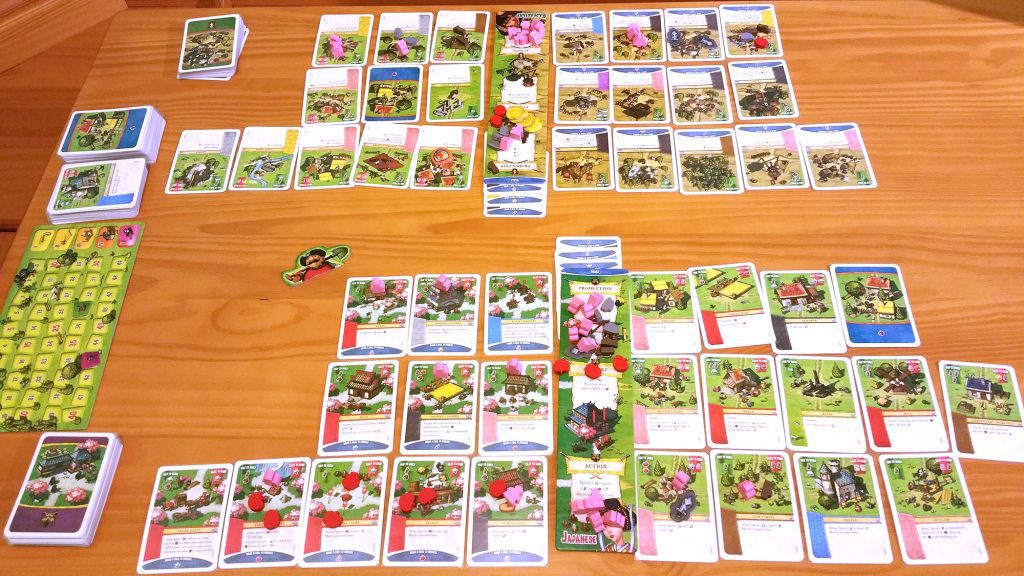
What captured my heart was finally getting to play it. Imperial Settlers is just an ingenious game that continually tests your decision making skills as well as your mettle. In order to be successful, you must first get a good production engine going so that you can actually do things. But, that’s not always easy. Sometimes the cards just will not come up in your favor. That’s where making deals comes in useful. However, making a deal for something that you desperately need will usually mean having to give up a really good faction card to do so. Should you make the deal and give up the card or risk it all and hope to draw what you need?
Central to the theme of this game is the idea of civilization and engine building. When the game begins, you start with almost nothing. That first round is incredibly hard and it can feel disheartening to end the round with only one or two cards in play. But, as each round goes by and your empire begins to inflate and expand, the action really ramps up and it becomes a challenge to try to squeeze as much out of the turn as possible. It gets especially exciting when your opponents are right behind you on the scoring track, nipping at your heels.
Should you focus on playing out as many faction cards as you can at this point to try to earn just a few more points at the end of the game? Or should you divert your resources to trying to eke out points some other way? Imperial Settlers is full of little micro-decisions like these and that really speaks to me. I enjoy the challenge of trying to make the most out of the hand that you’ve been dealt.
Even your choice of which faction to play really matters. Each faction has its own unique flavor and each plays differently from the other ones, so choosing a faction in this game actually makes a difference. It isn’t like just choosing a player color. And these factions are very well-balanced. There aren’t any that are clearly more powerful or better than the others. Regardless of which you choose to play with, you can rest assured that you’ve got a very good shot at winning.

Needless to say, Imperial Settlers has won me over. It puts a check in every box. Lots of awesome components? Check. Immersive and challenging gameplay? Check. Attractive artwork? Check. Lots of replayability? Check. Scales well with different groups of people? Check. Check. Check. All of the boxes. All of them. I cannot recommend this game enough. Acquiring Imperial Settlers is the best thing I have ever done for my game collection.
And, if you think this sounds really good, just wait until you hear about the expansions!
But, we’ll save that for next time…



